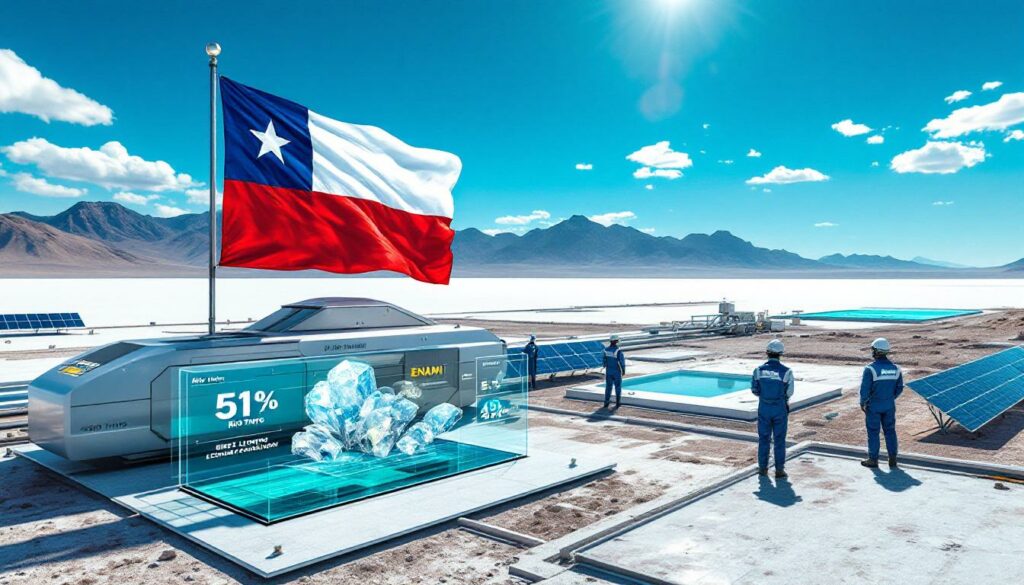Rio Tinto and ENAMI Joint Venture: Transforming Chile's Lithium Landscape
In a landmark development for the global lithium industry, Rio Tinto and Chile's state-owned mining company ENAMI have formalized a joint venture to develop the promising Altoandinos Lithium Project. This strategic partnership represents a significant advancement in Chile's lithium sector, positioning the South American nation to strengthen its role in the global battery minerals supply chain.
The collaboration brings together Rio Tinto's technological expertise and financial resources with ENAMI's local knowledge and government backing, creating a powerful alliance in one of the world's most lithium-rich regions. The partnership will also incorporate lithium industry innovations that could revolutionize extraction processes.
What is the Altoandinos Lithium Project?
The Altoandinos Lithium Project represents a significant lithium development initiative strategically positioned in Chile's mineral-rich Atacama region. This ambitious venture aims to develop what industry experts characterize as a "large-scale, long-life, low-cost lithium brine resource" with the potential to evolve into a world-class mining operation.
Located in the heart of South America's "Lithium Triangle," the project benefits from the region's exceptional geological advantages, including some of the world's highest-grade lithium brine deposits. The Atacama's unique conditions offer natural advantages for lithium production that few global locations can match.
Sinead Kaufmann, Rio Tinto Minerals CEO, highlighted the project's exceptional potential, noting it represents "a large-scale, long-life, low-cost lithium brine resource" situated in one of the world's premier lithium-producing regions.
Project Location and Significance
The project's strategic position in the Atacama region carries several distinct advantages:
- Resource quality: The area contains lithium brines with concentration levels exceeding 1,500 parts per million, among the highest globally
- Geographical efficiency: Natural solar evaporation conditions accelerate production processes
- Operational synergies: Proximity to existing mining infrastructure reduces development costs
- District potential: The area has potential to develop into an integrated copper and lithium production hub
The Altoandinos project stands apart from many global lithium developments due to its scale, resource quality, and strategic location. While lithium projects globally face various challenges including water scarcity and community relations, the partnership's technological approach aims to address these concerns through innovative lithium extraction methods.
How Did Rio Tinto Secure the Partnership?
Rio Tinto's selection as ENAMI's development partner followed an extensive and highly competitive evaluation process spanning nearly a year. The journey from initial proposal to binding agreement demonstrates the rigorous assessment conducted by Chilean authorities to ensure optimal development of this strategic national resource.
The Selection Process
The partnership's formation followed a carefully structured timeline:
- Initial shortlisting (August 2024): Rio Tinto was selected among six international mining and technology companies
- Technical evaluation phase (September 2024-April 2025): Assessment of extraction technologies, environmental approaches, and financial models
- Preferred partner announcement (May 2025): Rio Tinto emerged as ENAMI's preferred development partner
- Binding agreement (July 2025): Formal joint venture structure finalized
ENAMI's selection criteria focused heavily on technological innovation, financial capacity, and environmental stewardship. Rio Tinto's Direct Lithium Extraction (DLE) technology proved particularly compelling, offering significant advantages over traditional evaporation methods used by competitors.
Competing Companies in the Selection
The bidding process attracted global interest, with major players from three continents vying for the partnership:
| Company | Country/Origin | Notable Strengths |
|---|---|---|
| BYD Chile | China | Vertical integration with EV manufacturing |
| CNGR Advanced Material | China | Battery materials expertise |
| Eramet Chile | France | Established lithium extraction experience |
| LG Energy Solution | South Korea | Battery production integration |
| POSCO | South Korea | Advanced materials technology |
| Rio Tinto | Australia/UK | Financial strength and DLE technology |
Rio Tinto's successful bid highlighted its technological advantages in DLE implementation, which promises significant environmental benefits compared to conventional extraction methods. This technological edge, combined with the company's financial capacity to fully fund development stages, ultimately secured its position as ENAMI's preferred partner.
What Are the Key Terms of the Joint Venture?
The partnership between Rio Tinto and ENAMI establishes a clear framework for project development, with defined responsibilities and contributions from each party. The terms reflect a balanced approach that protects Chile's national interests while providing Rio Tinto with sufficient operational control to implement its technological solutions.
Ownership Structure and Financial Commitments
The joint venture's structure includes several key elements:
- Ownership division: Rio Tinto holds a 51% controlling interest, while ENAMI retains a substantial 49% stake
- Financial commitment: Rio Tinto will contribute up to $425 million (£313.81 million) in combined cash and non-cash investments
- Development funding: Rio Tinto will exclusively finance the pre-feasibility study and subsequent development phases
- Stage-gate approach: Funding releases are tied to specific project milestones and investment reviews
The financial structure reflects a phased development approach, with Rio Tinto's investments contingent on successful progression through defined project stages. This approach mitigates risk while ensuring sufficient capital for comprehensive resource evaluation and development planning.
Technology Transfer and Development Approach
A cornerstone of the agreement involves Rio Tinto's commitment to deploy its proprietary Direct Lithium Extraction technology:
- Technology contribution: Rio Tinto's DLE technology forms a significant portion of its non-cash investment
- Knowledge transfer: The partnership includes provisions for technical training and capacity building
- Environmental focus: DLE implementation aims to reduce water consumption by approximately 50% compared to traditional methods
- Operational efficiency: The technology potentially accelerates production timelines while improving lithium recovery rates
The technology transfer component represents a significant value proposition for Chile, providing access to advanced extraction methods that may revolutionize the country's lithium industry. For Rio Tinto, the arrangement secures access to premium lithium resources while showcasing its technological capabilities.
"This partnership exemplifies how we are executing our strategy of building a world-class lithium portfolio to position Rio Tinto as a global leader in the responsible supply of critical minerals essential to the energy transition," noted Sinead Kaufmann, Rio Tinto Minerals CEO.
Why is the Atacama Region Strategically Important?
The Atacama region represents one of the world's most valuable lithium production zones, offering exceptional geological advantages that translate to competitive production costs and superior resource quality. Understanding these advantages provides context for the strategic importance of the Altoandinos project.
Geological Significance
The Atacama's unique characteristics create ideal conditions for lithium production:
- Superior concentration: Lithium brines in the region typically contain 1,000-1,500 ppm lithium, significantly higher than most global deposits
- Exceptional evaporation conditions: The Atacama is one of the driest places on Earth, with annual rainfall under 15mm and evaporation rates exceeding 3,500mm
- Minimal impurities: Lower magnesium-to-lithium ratios reduce processing complexity and costs
- Accessibility: Relatively shallow brine aquifers simplify extraction processes
These geological advantages translate directly to economic benefits, with Atacama-based operations consistently ranking among the world's lowest-cost lithium producers. For context, production costs in the Atacama can be 30-50% lower than those for hard-rock lithium mining operations in Australia.
Economic and Strategic Value
Beyond pure geology, the region offers several strategic advantages:
- Infrastructure access: Established transportation networks, power infrastructure, and processing facilities
- Operational expertise: Existing operations provide a skilled labor pool and supplier network
- Export efficiency: Proximity to Pacific ports facilitates global distribution
- Mineral diversity: The region's copper resources create potential for integrated mining operations
The Atacama's strategic importance extends beyond Chile's borders, representing approximately 23% of the world's known lithium resources. As global lithium market trends show increasing demand for battery materials, control of these premium resources becomes increasingly valuable for both economic and geopolitical reasons.
What Timeline Has Been Established for the Project?
The Altoandinos project follows a structured development timeline that balances the urgency of bringing new lithium supplies to market with the technical and regulatory requirements of responsible resource development. This phased approach allows for appropriate risk management while maintaining development momentum.
Development Schedule
The joint venture has established key milestones for project advancement:
- Transaction closing: Expected in the first half of 2026
- Pre-feasibility study: To commence immediately following transaction closing
- Feasibility study: Contingent on pre-feasibility results and investment review
- Construction decision: Subject to comprehensive feasibility analysis and final investment approval
This measured approach reflects the complexity of developing a world-class lithium operation, with each stage building upon previous findings to refine the project's technical and economic parameters.
Regulatory Requirements
Several regulatory processes must be navigated successfully:
- Foreign investment approval: Review by Chile's foreign investment committee
- Environmental impact assessment: Comprehensive evaluation of potential environmental effects
- Water rights authorization: Securing necessary water access permits
- Community consultation: Engagement with local and indigenous communities as required by Chilean law
Chile's regulatory framework for lithium has evolved significantly in recent years, with the 2023 National Lithium Strategy establishing new guidelines for project development. The Altoandinos joint venture represents one of the first major projects to advance under this updated framework, potentially setting important precedents for future developments.
Disclaimer: Project timelines are subject to regulatory approvals, technical developments, and market conditions. The schedule outlined represents current expectations but may be adjusted as the project progresses.
How Does This Fit Into Rio Tinto's Strategic Vision?
The Altoandinos joint venture represents a significant advancement in Rio Tinto's strategic pivot toward battery minerals and materials critical to the global energy transition. This partnership aligns with the company's broader objectives of portfolio diversification and positioning in high-growth markets.
Alignment with Corporate Strategy
For Rio Tinto, the Altoandinos project serves multiple strategic objectives:
- Portfolio diversification: Expands beyond traditional mining segments into high-growth battery materials
- Technology deployment: Provides a showcase for the company's proprietary DLE technology
- Market positioning: Strengthens Rio Tinto's role in the EV supply chain
- Growth platform: Creates potential for further lithium asset development
This joint venture builds upon Rio Tinto's existing lithium investments, including the Rincon project in Argentina acquired in 2022 for $825 million. Together, these assets position Rio Tinto to become a significant player in the global lithium market, potentially producing over 100,000 tonnes of lithium carbonate equivalent annually by 2030.
Environmental and Community Commitments
Beyond commercial objectives, Rio Tinto has emphasized sustainability as a core component of the project:
- Water stewardship: DLE technology reduces water consumption compared to traditional methods
- Land impact minimization: Smaller physical footprint than conventional evaporation operations
- Community engagement: Commitment to transparent consultation with local stakeholders
- Environmental standards: Pledge to implement industry-leading practices, including mining reclamation innovation
Sinead Kaufmann emphasized this approach, stating the company's development would be "guided by transparent and respectful engagement with communities, with a commitment to the highest environmental standards."
These commitments reflect both corporate values and practical considerations, as social license to operate has become increasingly critical for mining projects globally. Rio Tinto's approach incorporates lessons from past challenges in community relations, establishing a framework for responsible development.
What Technology Will Be Deployed at Altoandinos?
The technological foundation of the Altoandinos project centers on Rio Tinto's proprietary Direct Lithium Extraction (DLE) technology, representing a significant departure from traditional evaporation-based lithium production methods. This innovative approach promises substantial environmental and operational advantages.
Direct Lithium Extraction Innovation
DLE technology fundamentally transforms the lithium extraction process:
- Process fundamentals: Uses selective adsorption or ion exchange to extract lithium directly from brines
- Time efficiency: Reduces production time from 18+ months (evaporation ponds) to potentially weeks
- Resource optimization: Improves lithium recovery rates from approximately 40% to potentially 80%+
- Operational flexibility: Functions effectively in variable weather conditions, unlike evaporation ponds
The technology represents a significant advance over traditional methods that rely on large evaporation ponds to concentrate lithium through natural solar evaporation. While effective in the Atacama's dry climate, these conventional approaches face increasing scrutiny due to their environmental impact.
Environmental Advantages
DLE technology offers several sustainability benefits:
- Water conservation: Reduces freshwater consumption by approximately 50% compared to traditional methods
- Land use efficiency: Requires significantly less surface area than evaporation ponds
- Chemical reduction: More selective process reduces chemical inputs for purification
- Brine return: Allows for returning processed brine to aquifers, potentially reducing hydrological impacts
These environmental advantages address key concerns surrounding lithium production, particularly in the water-sensitive Atacama region. By implementing DLE technology, the joint venture aims to establish new standards for responsible lithium production that may influence industry practices globally.
It's worth noting that while DLE technologies show tremendous promise, large-scale commercial implementation remains limited. The Altoandinos project represents an important test case for these emerging technologies, with potential implications for the broader lithium industry.
What Are the Market Implications of This Development?
The Altoandinos joint venture enters a dynamic global lithium market characterized by rapidly evolving supply-demand dynamics and strategic repositioning by major players. Understanding these market implications provides context for the project's significance beyond its immediate commercial value.
Impact on Global Lithium Supply
The project's development could significantly influence lithium markets:
- Supply diversification: Adds a major new source outside the dominant Australia-China supply chain
- Production quality: Expected to yield battery-grade lithium with lower impurity levels
- Cost positioning: Potential to operate in the lowest quartile of the global cost curve
- Market timing: Development timeline coincides with projected supply deficits in the late 2020s
Industry analysts project global lithium demand to reach approximately 3.7 million tonnes LCE (lithium carbonate equivalent) by 2035—roughly five times current production levels. The Altoandinos project could become a significant contributor to meeting this growing demand, particularly for high-quality battery-grade materials.
Economic Benefits for Chile
For Chile, the joint venture offers substantial economic advantages:
- Employment creation: Hundreds of direct jobs during construction and operation phases
- Skills development: Technical training and capability building in advanced extraction methods
- Export revenues: Potential for billions in export earnings over the project's life
- Industrial development: Opportunity to develop downstream processing capabilities
Chile currently accounts for approximately 30% of global lithium production but has seen its market share decline as Australian hard-rock production has expanded. The Altoandinos project represents an opportunity to reinforce Chile's position as a premium lithium producer while modernizing its production methods.
The partnership model also represents an evolution in Chile's approach to lithium development, balancing foreign investment and technology with retention of significant national ownership. This model may serve as a template for future resource development projects in the country.
Disclaimer: Market projections involve inherent uncertainties, including potential technological disruptions, demand fluctuations, and competitive developments. The actual market impact will depend on numerous factors beyond the control of the joint venture partners.
What Challenges Might the Project Face?
Despite its significant potential, the Altoandinos project will navigate various challenges common to major lithium developments, particularly in environmentally and socially sensitive regions. Recognizing these challenges is essential for understanding the project's risk profile and development trajectory.
Development Considerations
Several operational and technical challenges warrant consideration:
- Water management: Even with DLE technology, water usage remains a sensitive issue in the arid Atacama
- Technology scale-up: Commercial implementation of DLE at large scale carries technical uncertainties
- Infrastructure development: Power, transportation, and processing facilities require substantial investment
- Market volatility: Lithium price fluctuations impact project economics (prices fell over 70% in 2023 before partially recovering)
Water management represents a particularly significant challenge, with lithium operations competing with agriculture, tourism, and ecosystems for limited water resources. The project's environmental approach will need to address these concerns comprehensively to secure both regulatory approval and social acceptance.
Regulatory Framework
Chile's evolving regulatory environment presents both opportunities and challenges:
- National Lithium Strategy: Chile's 2023 policy framework emphasizes public-private partnerships
- Indigenous consultation: Requirements under ILO Convention 169 mandate thorough community engagement
- Environmental permitting: Increasingly rigorous standards for water usage and ecosystem protection
- Political considerations: Lithium's designation as a strategic mineral subjects it to heightened oversight
The project enters a period of regulatory transition, as
Ready to Identify the Next Major ASX Mineral Discovery?
Don't miss out on potential life-changing investment opportunities in the mining sector. Visit Discovery Alert's discoveries page to learn how their proprietary Discovery IQ model provides real-time alerts on significant ASX mineral announcements, giving you the market edge before others catch on.




